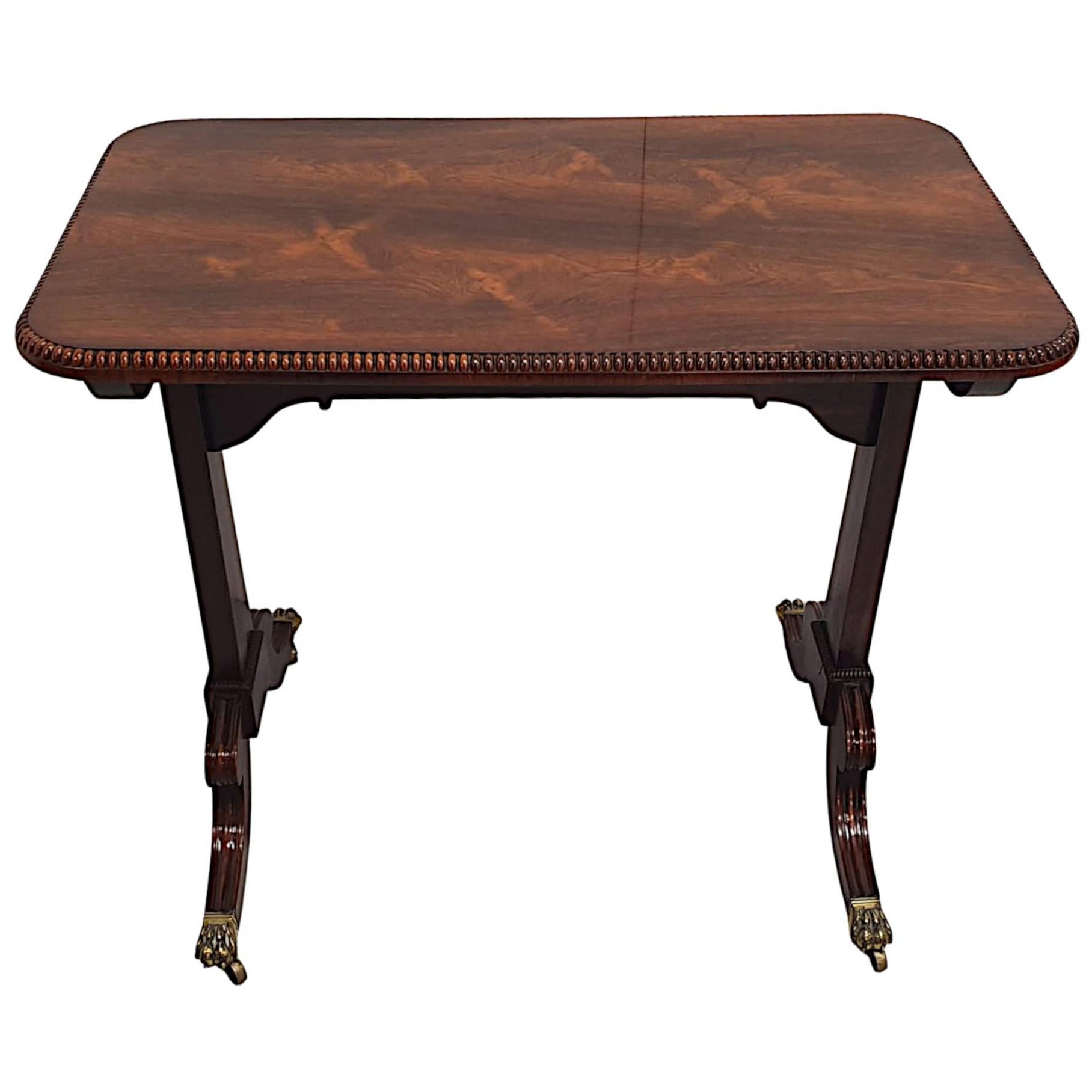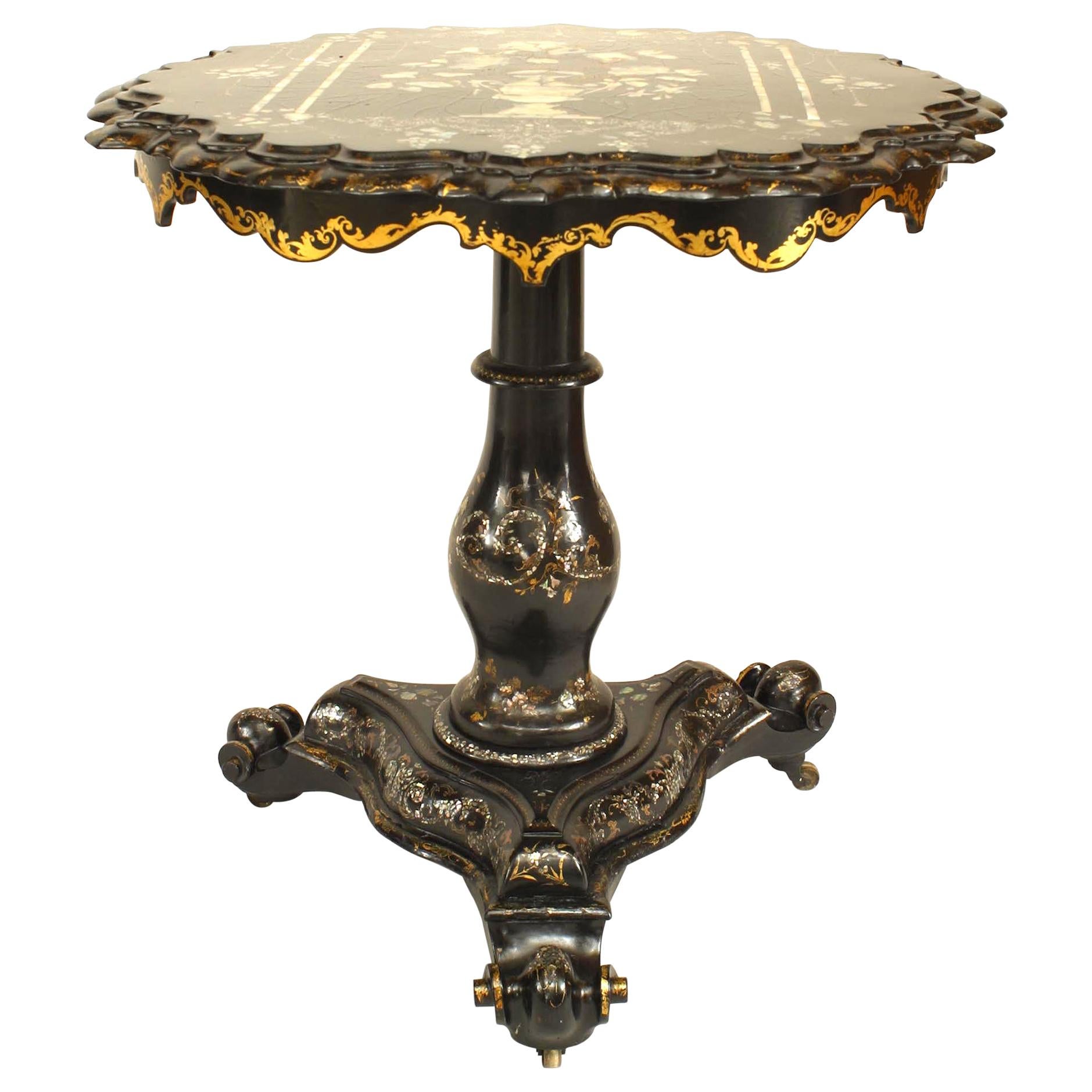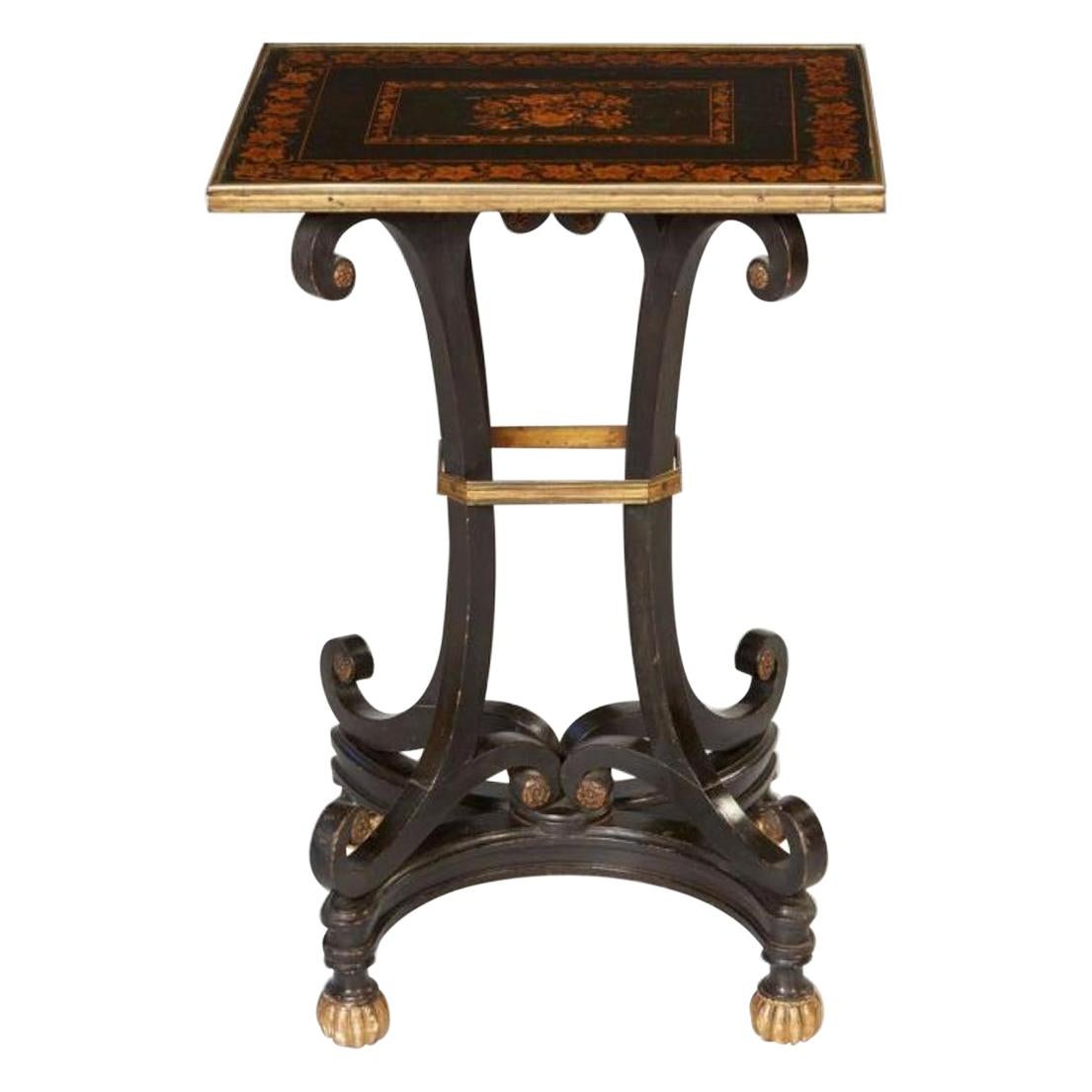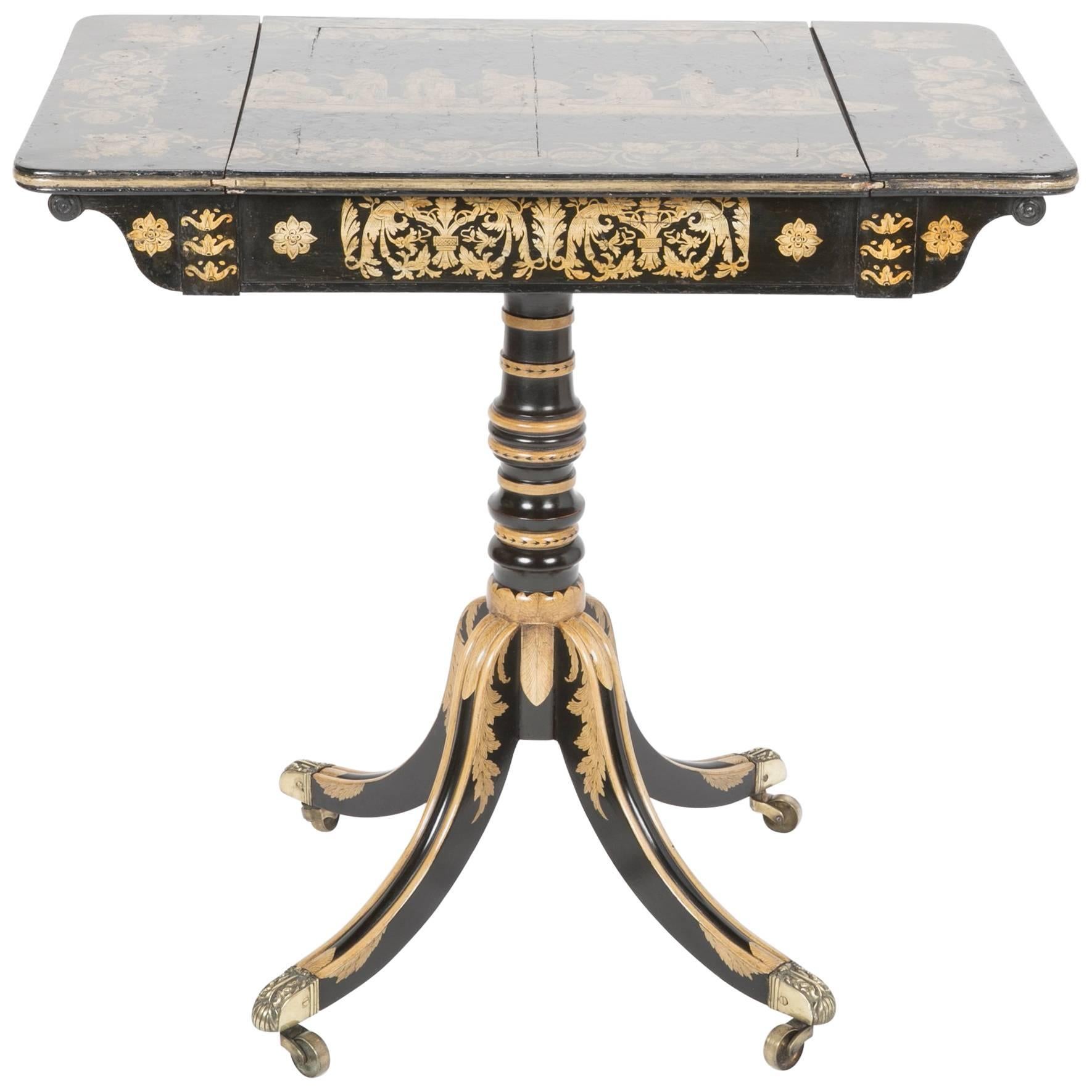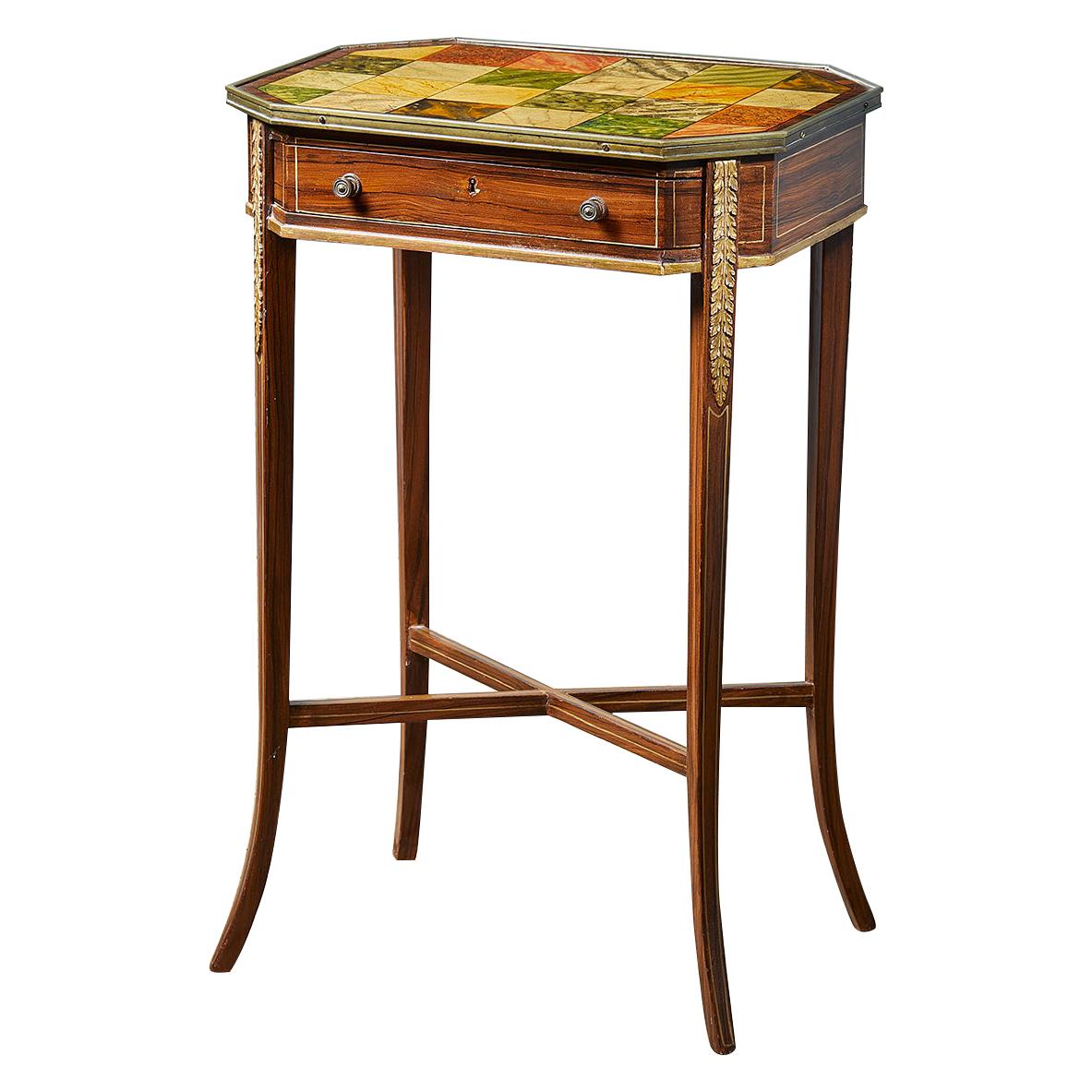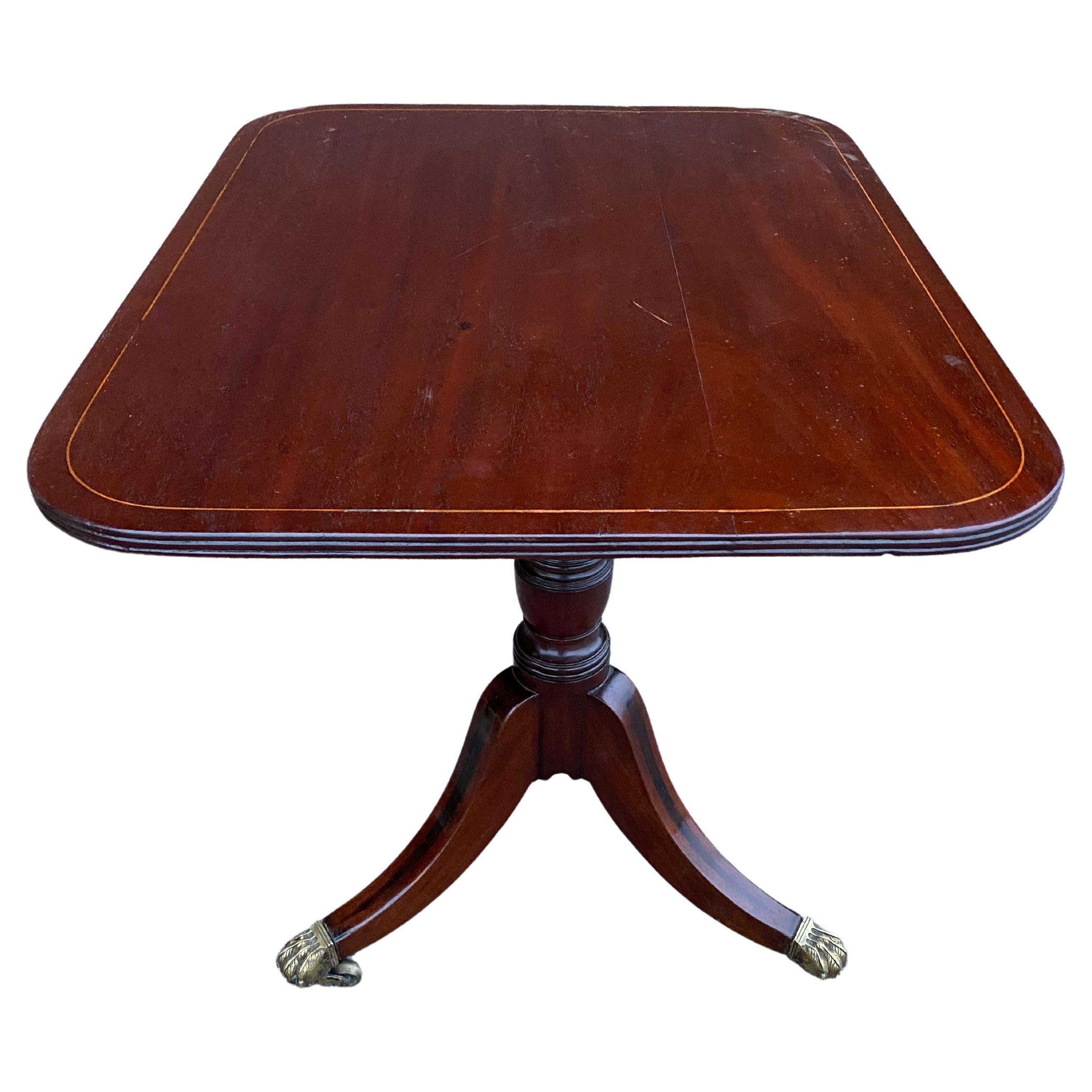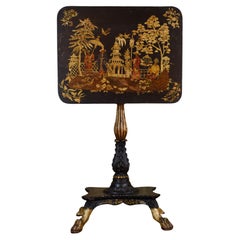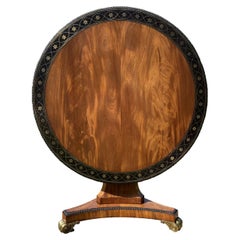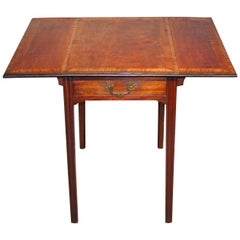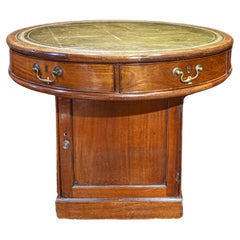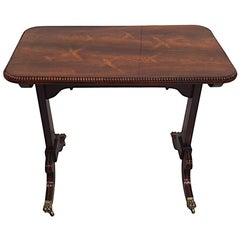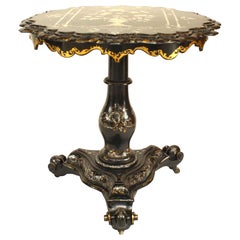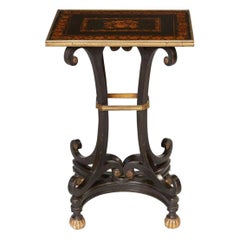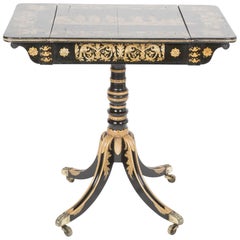Items Similar to An English Regency period penwork occasional table
Video Loading
Want more images or videos?
Request additional images or videos from the seller
1 of 6
An English Regency period penwork occasional table
$5,191.01
£3,800
€4,467.66
CA$7,119.80
A$8,002.18
CHF 4,167.32
MX$97,326.31
NOK 53,326.03
SEK 50,568.79
DKK 33,343.64
Shipping
Retrieving quote...The 1stDibs Promise:
Authenticity Guarantee,
Money-Back Guarantee,
24-Hour Cancellation
About the Item
An English Regency-period chinoiserie penwork occasional table, circa 1815.
The unusual rectangular gentle-serpentine top profusely decorated and centred by a chinoiserie scene of a man, woman and child, flanked by two large urns from which (possibly mulberry) vines are emerging, the whole surrounded by fine complex floral decoration with a chequer-work border.
Raised on an ebonised base with elongated lotus on a concave quadruped base. A useful and attractive early-19th century table in lovely condition, in its original state. A chic antique.
Nb. Items decorated with penwork come in many shapes and sizes. The most common occur in the form of boxes and games tables with chequerboard tops, the less common in the form of small cabinets.
Penwork:
A form of decoration popular during the late-eighteenth and early-nineteenth centuries, and practised mostly by amateurs along with japanning, needlework and drawing etc, usually by talented aristocratic ladies. The craze was for orientalist designs and much penwork followed this pattern as well as with scenes from classical antiquity. Penwork was executed with fine quill pens and brushes showing charming, often naïve subjects reflecting the amateur nature of the artist. Chessboard tops are a common subject. Layers of varnish would have originally been applied for protection.
Penwork is considered very stylish and much favoured by top interior designers and collectors alike. Condition is important as penwork can be costly to restore.
In June 1810, bookseller Rudolf Ackermann, owner of The Repository of the Arts in the Strand, London, published the first known reference to penwork decoration in his periodical Repository of Arts referring to compositions with ''a black ground, in imitation of Indian ivory inlaid work.'' He supplied all necessary materials and equipment for customers to undertake the art of penwork, which at the time was primarily performed by women of a higher social standing who had time to devote to creative pursuits.
References:
Rudolph Ackermann - Wikipedia
During the height of penwork popularity around 1820, the Prince Regent, George IV, had great influence over the decorative schemes present at the time, popularising chinoiserie decorations as seen in The Brighton Pavilion. Though penwork motifs could be procured from a variety of sources such as pattern books and other publications, many pieces were decorated by women working in their homes and therefore feature more unique decoration that may have been designed to match interiors, or even stemmed from their personal interest.
- Dimensions:Height: 28.15 in (71.5 cm)Width: 17.92 in (45.5 cm)Depth: 14.57 in (37 cm)
- Style:Regency (Of the Period)
- Materials and Techniques:Serpentine
- Place of Origin:England
- Period:19th Century
- Date of Manufacture:circa 1815
- Condition:Wear consistent with age and use. A versatile and very decorative early-19th century table in lovely condition, in its original state.
- Seller Location:Lymington, GB
- Reference Number:Seller: BHA 12441stDibs: LU4081131305682
About the Seller
5.0
Vetted Professional Seller
Every seller passes strict standards for authenticity and reliability
Established in 1957
1stDibs seller since 2018
36 sales on 1stDibs
- ShippingRetrieving quote...Shipping from: Lymington, United Kingdom
- Return Policy
Authenticity Guarantee
In the unlikely event there’s an issue with an item’s authenticity, contact us within 1 year for a full refund. DetailsMoney-Back Guarantee
If your item is not as described, is damaged in transit, or does not arrive, contact us within 7 days for a full refund. Details24-Hour Cancellation
You have a 24-hour grace period in which to reconsider your purchase, with no questions asked.Vetted Professional Sellers
Our world-class sellers must adhere to strict standards for service and quality, maintaining the integrity of our listings.Price-Match Guarantee
If you find that a seller listed the same item for a lower price elsewhere, we’ll match it.Trusted Global Delivery
Our best-in-class carrier network provides specialized shipping options worldwide, including custom delivery.More From This Seller
View AllFine Rare Regency Chinoiserie Occasional Table
Located in Lymington, GB
A fine and rare English chinoiserie-decorated occasional table, circa 1820.
The subject matter is extremely rare in that it depicts Europeans in exotic oriental robes. One is seated with an opium pipe; displayed in a polychrome romantic tropical environment with pavilions, rockwork, trellising, foliage, palms, with a peacock and HoHo bird at their feet.
Note the very rare and charming depiction of these men with beards. In over 67 years we have never encountered a japanned table showing this European feature.
Raised on a gilded, reeded, partly-ebonised column rising from a stylised platform base and spreading, gilded animal...
Category
Antique 1820s English Chinoiserie Tables
Materials
Wood
Fine Regency Mahogany Library Centre Table
Located in Lymington, GB
A fine Regency-period tilt-top brass inlaid mahogany and calamander library center table.
Raised on a concave-sided triform base, with well-modelled cast-brass scrolling feet.
Also referred to as a monopodium (table).
All in excellent condition, well figured, and of very good rich color.
Typical of designs by Thomas Hope (1769 - 1831).
This form of antique table is also associated with work by George Bullock (1777 - 1818) and George Oakley (circa 1765 - 1841).
Refs:
A similar table with a leather insert, in the manner of Thomas Hope, circa 1800 - 1805, was sold in London for £39,650 - December 2010.
This early 19th century table is reminiscent of the ‘Grecian’ style that the pioneering collector and designer Thomas Hope (1769-1831) popularized in Britain with the publication of ‘Household Furniture and Interior Decoration’ in 1807.
Thos. Hope (banker, born 1769, d. 1831)
The furniture manufacturer George Oakley (circa 1765-1841) was greatly influenced by Hope’s designs, and produced fashionable furniture in this style, using brass and star inlays similar to our table on offer. The firm’s designs and craftsmanship earned them royal patronage, and Oakley worked for the Prince Regent at Carlton House, as well as supplying furniture and upholstery for The Mansion House and The Bank of England. His work for the Cheere family - of Papworth Hall, Cambridgeshire, UK - is well documented.
The reference to Geo. Oakley relates to a known table of this pattern in calamander wood and brass marquetry of starred-ribbon guilloche, which corresponds to the brass marquetry in a table supplied by Oakley in 1810 to Papworth Hall.
Literature:
Parker, R. 'History of Papworth Everard...
Category
Antique Early 1800s English Regency Center Tables
Materials
Mahogany
George III Period Satinwood Pembroke Table
Located in Lymington, GB
A late 18th century satinwood Pembroke table of very good rich color.
George III period.
The top crossbanded in satinwood, bordered with fine lozenges of ebony stringing.
The edges ebonized with narrow mahogany crossbandings.
Raised on moulded tapering legs, indicative of a date circa 1770.
The frieze with two working mahogany-lined short drawers retaining the original gilt-brass Rococo mounts.
The two leaves are supported on the original recessed hinged ‘ear’ supports.
Overall in lovely original state. Some minor historic marks entirely commensurate with its age. Very good patination.
These antique Pembroke tables were designed to be versatile: as small supper tables; occasional tables; tea tables; or lamp tables - sometimes also referred to as ‘drop leaf’ or ‘sofa’ tables.
The majority of these Georgian tables are raised on square tapering legs or, when of a later date, on turned legs. It is more unusual for a satinwood Pembroke table to be raised on moulded tapering legs.
Interestingly, Thomas Sheraton (1751-1806) mentions the Pembroke table as follows: “a type of breakfast table from the name of the lady who first gave orders for one of them”, possibly referring to the Countess of Pembroke, of Wilton House, Salisbury, (1737-1831).
A similar George III satinwood Pembroke table...
Category
Antique 1770s English Tables
Materials
Satinwood
George III Gillows Mahogany Rent Table
By Gillows of Lancaster & London
Located in Lymington, GB
A fine and rare English revolving drum-top library table in mahogany, attributed to Gillows of Lancaster, circa 1770.
This is a rare, compact form of a George lll-period drum-top library table in superb condition, retaining excellent colour and patina throughout.
The circular top fitted with green leather insert with gilt-embossed border rotates. The six working drawers retain their original brass handles - some of these frieze drawers with subdivisions for monies/ documents - faced with ivory numbers 1-6.
The fully-rotating top retaining its original internal steel castors, raised on a cabinet base with a locking cupboard - with original lock, period key and original brass pull - and a shelf within. The moulded panel above a generous plinth.
These are sometimes referred to as 'rent' tables when they have a recess for depositing cash. This library table has divisions in secure drawers fulfilling much the same purpose of receiving rent from an Estate's tenant(s).
The base would typically contain larger account books...
Category
Antique 18th Century English George III Tables
Materials
Mahogany
Fine and Rare George II Mahogany Galleried Octagonal Table
Located in Lymington, GB
This fine, larger than usual, George ll-period table has a baluster-galleried octagonal top supported on a birdcage, allowing the top to both swivel and tilt. Note the fine, tapering, fluted column continuing into a carved collar. The well-drawn cabriole tripod base is foliate-carved at the knees and toes.
Of lovely old colour and patina throughout and in original condition. The spindle gallery has a rare and original feature of elegant brass 'spacers' with slightly protruding brass studs. Note the one-piece, beautifully-figured top.
Vis. A similar tripod table from the Percival Griffiths Collection is illustrated in R. W. Symonds 'English Furniture from Charles ll to George ll' (1929) fig. 152.
Another was sold from the Frederick Howard Reed Collection by Christies on 16th November 1955.
Literature:
Ralph Edwards CBE FSA, 'The Shorter Dictionary of English Furniture' (1964), p. 529, fig 8.
R. W. Symonds, 'The Present State of Old English Furniture' (1921), fig. 26. col B, p.82.
R. W. Symonds, 'English Furniture from Charles II to George II' (1929) from the Percival Griffiths collection (see black and white illustration fig. 190 p. 232).
References:
An English mahogany tripod of similar date but with a more elaborate support and fretted gallery was sold at Sotheby's New York, on 22nd October 2010 @ $74,500.
Bonhams sold a more common 'ball and claw’ piecrust table...
Category
Antique Mid-18th Century English George II Tables
Materials
Mahogany
Fine Chippendale Period Carved Silver Table, circa 1760
Located in Lymington, GB
A fine English Chippendale-period silver table. George III.
This is a particularly refined and beautifully-controlled version of a mid-18th century mahogany silver table. Raised on ...
Category
Antique Mid-18th Century English George III Sofa Tables
Materials
Mahogany
You May Also Like
Very Fine and Rare Early 19th Century Regency Side or Lamp Table
Located in Dublin, IE
A very fine and rare early 19th century Regency fruitwood side or lamp table, of gorgeous quality and beautifully hand carved with rich patination and grain. The well figured, moulde...
Category
Antique 19th Century English Side Tables
Materials
Brass
English Victorian Paper Mâché Lacquered End Table
Located in Queens, NY
English Victorian paper mâché black lacquered and pearl inlaid pedestal base tilt top end table with scalloped edge and floral decoration.
Category
Antique 19th Century English Victorian Pedestals
Materials
Mother-of-Pearl, Wood
Regency Penwork Table
Located in Greenwich, CT
Very fine Regency period side table having a penwork decorated top with chased gilt bronze molded edge over curule legs joined by gilt bronze...
Category
Antique 19th Century British Regency Side Tables
Materials
Bronze
$5,900
English Regency Penwork Games Table
Located in Stamford, CT
Penwork games table with pedestal on four legs and wheeled feet, English, circa 1810.
Category
Antique 1810s English Regency Game Tables
Materials
Wood
Late 18th Century Regency Occasional Table
Located in Petworth, West Sussex
A Regency period occasional table painted to simulate marbles and rosewood, English circa 1790-1810, the canted rectangular top painted in a variety of colors with twenty-four panels...
Category
Antique Late 18th Century British Regency Side Tables
Materials
Bronze
$3,223 Sale Price
20% Off
19th Century English Regency Inlaid Side Table on Paw Castors
Located in Richmond, VA
Great little 19th century English Regency tilt top mahogany side table with string inlaid top, ebony inlaid legs and paw foot castors.
Category
Antique Early 19th Century English Regency Side Tables
Materials
Ebony, Mahogany
More Ways To Browse
Indian Prince
Antique Japanese Ivory
Ivory Inlaid
Pavilion Antiques
English Chinoiserie Cabinet
19th Century Japanese Ivory
Lotus Cabinet
Small Indian Cabinets
Brighton Table
Antique Needlework Table
Ivory Inlaid Table
Ivory Inlaid Box
Ivory Inlaid Cabinet
Quill Table
Antique Quill Pen
Quill Box
Indian Ivory Box
Regency Penwork
